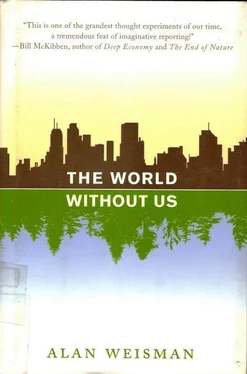If everyone had vanished or fled with the plant still producing electricity, it would keep running until any one of thousands of parts monitored daily by maintenance personnel failed. A failure should automatically trigger a shutdown; if it didn’t, the meltdown might occur quite quickly. In 1979 something similar happened at Pennsylvania’s Three Mile Island Plant when a valve stuck open. Within two hours and 15 minutes, the top of the core was exposed and turned into lava. As it flowed to the bottom of the reactor vessel, it started burning through six inches of carbon steel.
It was a third of the way through before anyone realized. Had no one discovered the emergency, it would have dropped into the basement, and 5,000°F molten lava would have hit nearly three feet of water flooded from the stuck valve, and exploded.
Nuclear reactors have far less concentrated fissionable material than nuclear bombs, so this would have been a steam explosion, not a nuclear explosion. But reactor containment domes aren’t designed for steam explosions; as its doors and seams blow out, a rush of incoming air would immediately ignite anything handy.
If a reactor was near the end of its 18-month refueling cycle, a meltdown to lava would be more likely, because months of decay build up considerable heat. If the fuel was newer, the outcome might be less catastrophic, though ultimately just as deadly. Lower heat might cause a fire instead of a meltdown. If combustion gases shattered the fuel rods before they turned to liquid, uranium pellets would scatter, releasing their radioactivity inside the containment dome, which would fill with contaminated smoke.
Containment domes are not built with zero leakage. With power off and its cooling system gone, heat from fire and fuel decay would force radioactivity out gaps around seals and vents. As materials weathered, more cracks would form, seeping poison, until the weakened concrete gave way and radiation gushed forth.
If everyone on Earth disappeared, 441 nuclear plants, several with multiple reactors, would briefly run on autopilot until, one by one, they overheated. As refueling schedules are usually staggered so that some reactors generate while others are down, possibly half would burn, and the rest would melt. Either way, the spilling of radioactivity into the air, and into nearby bodies of water, would be formidable, and it would last, in the case of enriched uranium, into geologic time.
Those melted cores that flow to the reactor floors would not, as some believe, bore through the Earth and out the other side, emerging in China like poisonous volcanoes. As the radioactive lava melds with the surrounding steel and concrete, it would finally cool—if that’s the term for a lump of slag that would remain mortally hot thereafter.
That is unfortunate, because deep self-interment would be a blessing to whatever life remained on the surface. Instead, what briefly was an exquisitely machined technological array would have congealed into a deadly, dull metallic blob: a tombstone to the intellect that created it—and, for thousands of years thereafter, to innocent nonhuman victims that approach too closely.
They began approaching within a year. Chernobyl’s birds disappeared in the firestorm when Reactor Number Four blew that April, their nest building barely begun. Until it detonated, Chernobyl was almost halfway to becoming the biggest nuclear complex on Earth, with a dozen one-megawatt reactors. Then, one night in 1986, a collision of operator and design mistakes achieved a kind of critical mass of human error. The explosion, although not nuclear—only one building was damaged—broadcast the innards of a nuclear reactor over the landscape and into the sky, amid an immense cloud of radioactive steam from the evaporated coolant. To Russian and Ukrainian scientists that week, frantically sampling to track radioactive plumes through the soil and aquifers, the silence of a birdless world was unnerving.
But the following spring the birds were back, and they’ve stayed. To watch barn swallows zip naked around the carcass of the hot reactor is discombobulating, especially when you are swaddled in layers of wool and hooded canvas coveralls to block alpha particles, with a surgical cap and mask to keep plutonium dust from your hair and lungs. You want them to fly away, fast and far. At the same time, it’s mesmerizing that they’re here. It seems so normal, as if apocalypse has turned out to be not so bad after all. The worst happens, and life still goes on.
Life goes on, but the baseline has changed. A number of swallows hatch with patches of albino feathers. They eat insects, fledge, and migrate normally. But the following spring, no white-flecked birds return. Were they too genetically deficient to make the winter circuit to southern Africa? Does their distinctive coloring make them unappealing to potential mates, or too noticeable to predators?
In the aftermath of Chernobyl’s explosion and fire, coal miners and subway crews tunneled underneath Number Four’s basement and poured a second concrete slab to stop the core from reaching groundwater. This probably was unnecessary, as the meltdown was over, having ended in a 200-ton puddle of frozen, murderous ooze at the bottom of the unit. During the two weeks it took to dig, workers were handed bottles of vodka, which, they were told, would inoculate them against radiation sickness. It didn’t.
At the same time, construction began on a containment housing, something that all Soviet RMBK reactors like Chernobyl lacked, because they could be refueled faster without one. By then, hundreds of tons of hot fuel had already blown onto the roofs of adjacent reactors, along with 100 to 300 times the radiation released in the 1945 bombing of Hiroshima. Within seven years, radioactivity had eaten so many holes in the hastily built, hulking, gray five-story concrete shell, already patched and caulked like the hull of a rusting scow, that birds, rodents, and insects were nesting inside it. Rain had leaked in, and no one knew what vile brews steeped in puddles of animal droppings and warm, irradiated water.
The Zone of Alienation, a 30-kilometer-radius evacuated circle around the plant, has become the world’s biggest nuclear-waste dump. The millions of tons of buried hot refuse include an entire pine forest that died within days of the blast, which couldn’t be burned because its smoke would have been lethal. The 10-kilometer radius around ground zero, the plutonium zone, is even more restricted. Any vehicles and machinery that worked there on the cleanup, such as the giant cranes towering over the sarcophagus, are too radioactive to leave.
Yet skylarks perch on their hot steel arms, singing. Just north of the ruined reactor, pines that have re-sprouted branch in elongated, irregular runs, with needles of various lengths. Still, they’re alive and green. Beyond them, by the early 1990s, forests that survived had filled with radioactive roe deer and wild boars. Then moose arrived, and lynx and wolves followed.
Dikes have slowed radioactive water, but not stopped it from reaching the nearby Pripyat River and, farther downstream, Kiev’s drinking supply. A railroad bridge leading to Pripyat, the company town where 50,000 were evacuated—some not quickly enough to keep radioactive iodine from ruining their thyroids—is still too hot to cross. Four miles south, though, you can stand above the river in one of the best birding areas today in Europe, watching marsh hawks, black terns, wagtails, golden and white-tailed eagles, and rare black storks sail past dead cooling towers.
In Pripyat, an unlovely cluster of concrete 1970s high-rises, returning poplars, purple asters, and lilacs have split the pavement and invaded buildings. Unused asphalt streets sport a coat of moss. In surrounding villages, vacant except for a few aged peasants permitted to live out their shortened days here, stucco peels from brick houses engulfed by untrimmed shrubbery. Cottages of hewn timbers have lost roof tiles to tangles of wild grapevines and even birch saplings.
Читать дальше











